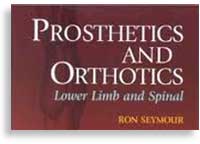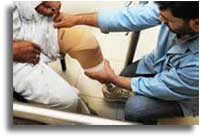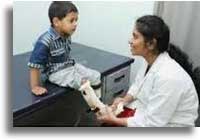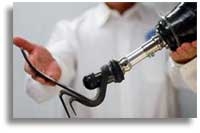PROSTHETICS AND ORTHOTICS
Career in Prosthetics and Orthotics
Prosthetics and Orthotics is a medical and engineering based healthcare profession which deals with rehabilitation of physically handicapped individuals who suffer from limb malfunctions or abnormalities or absence or loss of limbs or other body parts. The loss of body parts may have been the result of an accident or mishap or amputation owing to medical conditions like diabetes or gangrene or cancer or in some cases the defect may be congenital i.e people are born with this handicap where a limb / a body part may be missing. Such a condition prevents a person from leading a normal life. There may also be cases where people suffering from conditions like polio or muscular degeneration need an external support for movement and strength to go about their day to day activities.
Prosthetists and Orthotists are professionals who help people suffering from neuromotor and musculoskeletal disorders such as the ones mentioned above, to return to a normal life by using their skills and advanced medical technology. In a nutshell, though the fields Prosthetics and Orthotics appear to be autonomous, these professionals usually work as part of multi-skilled teams. Their clientele ranges from small children to adults and elderly population suffering from age-related injuries and illnesses.A Prosthesis, or what is commonly known as an artificial limb is an extension or replacement of a missing or damaged body part. It can be an artificial leg, an entire hand or just the palms of hands or feet, etc. Those professionals who deal with prosthesis are called Prosthetists.An Orthosis is a device which can give support to weak limbs or help to correct a deformity. It is derived from the Greek word 'ortho' meaning 'to straighten'. Such devices include braces, splints and special footwear which assist movement and tend to lessen the amount of discomfort. Orthotists are professionals concerned with manufacture and fitting of Orthosis.
Nature of work and Job Description

Eligibility and Course Areas
The minimum educational requirement to become a prosthetist and orthotist is a four and half year degree in Prosthetics and Orthotics from a recognised university. After graduation, in order to practice as prosthetist and orthotist in India candidates must register with the Rehabilitation Council of India.For admission to four and a half year bachelors' degree course in prosthetics and orthotics the candidates must have cleared 10 + 2 with Physics, Chemistry, Maths and Biology.Candidates aspiring for a masters' degree in prosthetics and orthotics should have a bachelor's degree in prosthetics and orthotics.

Course Areas:

Personal Skills:

Job Prospects and Career Options
- The nature of work of a prosthetist and orthotist involves various stages. To start with a P&O professional works as part of a clinical team which comprises of orthopaedics, physiatrists, nurses and related medical professionals. They have to study records and reports of a patient regarding the suitable orthotic/ prosthetic aid required and then have to communicate appropriate information regarding this to the patients and their families.
- They need to take measurements and casts required for the proper fabrication and fitting of Prosthetics and orthotics. They have to formulate designs and select materials and components for making the aids. All this requires detailed studies as the orthotic and prosthetic requirements of patients vary with the nature of disability, their body type, their working and living conditions, etc. In short, the prosthesis and orthosis have to be custom made.
- They then have to fit these aids and also teach their patients and their families, the use of these orthotic and prosthetic aids. They have to ensure that the fitting and alignment of the aids are proper and do not cause discomfort to the patients.
- A P&O professional's job does not end here. They have to take part in follow-up procedures, maintenance and replacement of the orthotic and prosthetic aids. They must supervise the activity of supporting staff, manage prosthetics and orthotics workshop, and maintain safe working environment and procedures. Those involved in training and education have to supervise and conduct education and training of prosthetics and orthotics student�s upto undergraduate level.
- They have to upgrade their skills form time to time and should keep abreast of the latest technology and breakthrough in this field. They also have to contribute to community rehabilitation programmes and improve social awareness as regards the use of prothesis and orthosis and safe medical practices.
- As regards the place of work of a P&O professional, they work in hospitals, clinics, laboratories, work room and fitting rooms, device manufacturing companies, rehabilitation departments of hospitals and government agencies, ambulatory care services and special treatment facilities like arthritis centres. Teaching and research and development are other options available to them.
- This profession is a time demanding one but brings with it good employment opportunities and self practice facilities. Based on such educational qualifications and professional experience P&O professionals may get posted as Technologists, Consultants, Prosthetists and Orthotists in the supervisory level, as Technicians or Assistants. With upgrading of skills and considerable amount of job experience they may become Head of the Department. Those in the teaching field can become Instructors and Lecturers. Yet others can join R&D cells of government organizations and MNCs as Researchers. Trained professionals can also start their own manufacturing and maintenance units.
Remuneration
Orthotists and Prosthetists usually get a basic pay in the range of Rs 4000-7000 initially plus other allowance. Those with experience and better qualification can earn upwards of Rs10000. Orthotic and Prosthetic Technicians have a pay range of Rs 4000- 6000 per month. Those in teaching field have salaries according to UGC norms.
Institutes
Prosthetics and Orthotics |
Success Stories
Physio-occupational therapy is usually a unique multifaceted treatment procedure to help neurologically affected patients to maximize their potential and gain skills to face challenging situations or disabilities. They help disabled individuals to engage in meaningful purposeful activity by planning and implementing activity based treatment program.Physiotherapist and Occupational Therapist usually aim at not just life, but "Quality Life" for the patients and the family. They provide holistic care of the patient taking into account the physical, mental, spiritual and psychological aspects of a patient's recovery.
The therapeutic stage consists of mostly exercises which provide help in regaining functional independence. Aids and adaptive devices are suggested. Environmental modifications are made incorporated to facilitate recovery.For patients who have to live with a permanent disability, vocational evaluation and guidance are provided. Liaison with other team members of the NRU helps to cover a wider arena of problems for the patients. Therapists help in effective reintegration of patients within the society.
The occupational therapist mostly helps to identify suitable employment opportunities and offer vocational guidance or help the patient to adjust to changed circumstances in his present job. The Indraprastha Apollo hospital is the only private hospital in India to offer the latest biofeedback therapy and the hyperbaric oxygen therapy as a part of a complete range of options for neurorehabilitation.
